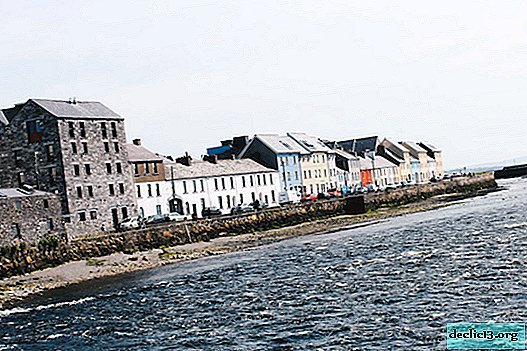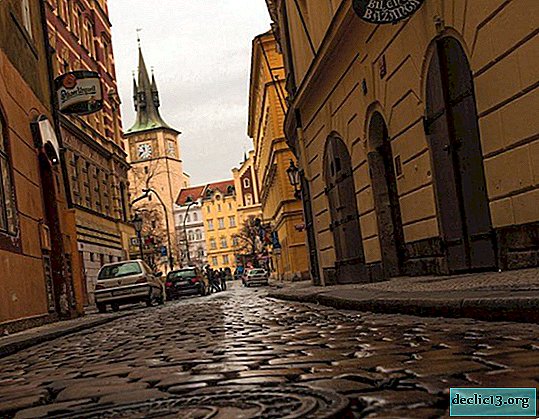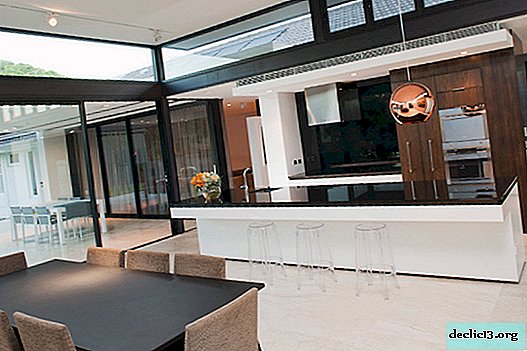Galway - A Holiday City in the West of Ireland
Galway, Ireland - the administrative center of County Galway, the main Atlantic port of the republic, the gateway to Gaeltacht and Connemara. The city is located in the west, at the mouth of the Korrib River. It is considered the cultural capital of Ireland, where pubs tirelessly rustle and a relaxed atmosphere reigns.

Good to know! About 2 million tourists arrive in Galway every year. Especially crowded in the city during the season of festivals that take place from early spring to mid-autumn. During this period, it is recommended to book reservations, as well as purchase tickets for events and excursions in advance.
General information
Galway is the fifth largest city in the republic and quite large (by the standards of the Irish), although it can be bypassed in three and a half hours. Here live 79,504 people (2017) who have no time to be bored, because Galway annually hosts festivals of international importance. For example, at the end of July, an art festival is held here, within the framework of which musical performances, performances and art exhibitions are shown for two weeks.
Good to know! An important role in preserving the Gaelic language and folk traditions is played by the Irish National University in Galway. His campus includes about a hundred buildings, including catering facilities, an art gallery and a theater - this is where the lion's share of city events is held.
 Korrib
KorribGalway owes its name to the small but impetuous Corrib River. In Gaelic, it is called Gaillimh, which means "rocky river." The city was built around the castle, built in 1124 by order of King Connaught (Irish western kingdom). The successful location of the settlement attracted many people to it and made it a welcome prey for the conquerors. In the 1230s the city was captured by the Anglo-Normans, led by Richard More de Bourg.
Fort Galway in the shortest possible time became successful, because merchant ships from France, Spain, Italy and the Middle East strove here. All power was concentrated in the hands of local merchants, until Cromwell’s troops after a months-long siege conquered the city during the war of 1639-1651. At the end of the XVII century, William III destroyed the Galway trading dynasties, after which he gradually fell into decay and began to recover only at the end of the last century.
Sights
 Lynch Castle
Lynch CastleResidents of Galway take care of the sights, rightfully considering them the property of Ireland. First of all, this refers to Lynch Castle, in which the bank is located today. This is the same Lynch, who in 1493 sentenced his own son to death. That is what we mean when we say "Lynch law."
Do not ignore attractions such as Kailmore Abbey, built in 1871, and the luxurious Ashford Castle, which is one of the most famous in Ireland. The first mention of Ashford dates back to the beginning of the XIII century, and today everyone can spend several days in the castle. And be sure to visit Air Square, named after the mayor of Galway.
Quay StreetQuay Street is a narrow cobbled street offering entertainment to everyone's taste. You can practice dancing art in one of the bars, have dinner in a modest cafe or a prestigious restaurant, or you can just take a walk while admiring the huge and almost doll-like houses made of stone. Most of the dwellings were built hundreds of years ago. They just ask for camera lenses, seducing with picturesque arches, cornices with flowers and lanterns.

The first houses began to appear here in the XIV century. At first, the street was chosen by the workers, and in the XIX century - the noble families of the city. Already in the last century, Quay began to be overgrown with all sorts of attractions and entertainment venues, which were visited by both locals and travelers.
Salthill QuayA walk through the Salthill Promenade is a favorite pastime for Galway residents and visitors. The two-kilometer embankment is perfectly lit, so it is suitable for leisurely walking, health jogging and cycling at any time of the day. In good weather, you can meet half of the city - someone breathes the salty air, someone goes to the beach, someone admires the waves, the flight of gulls or the sunset. It should be remembered that usually from the side of the ocean it blows a lot, so you should grab a jacket.
 Latin Quarter
Latin QuarterA view of the Latin Quarter opens right behind Air Square, attracting attention with colorful Victorian houses. Each seduces with signs of clothing stores, souvenir shops, jewelry stores and pubs. An amazing mixture of the spirit of antiquity and youthful carefreeness is floating in the air, for which tourists come here, and they are delighted to be entertained by street artists - musicians and circus artists, whose performances are gathered by crowds of onlookers.
 Cathedral (Galway Cathedral)
Cathedral (Galway Cathedral)The Cathedral of the Assumption of the Virgin Mary and St. Nicholas, whose green dome is more than 40 meters high, can be seen from afar, it looks old, although it was built in 1958 and consecrated in 1965. Galway Cathedral is located in the city center and is one of the brightest attractions.

The youngest stone cathedral, not only in Ireland, but throughout Europe, was erected on the site of a notorious prison due to ruthless overseers. And if earlier this point was bypassed, now the attraction attracts thousands of people.

Architect D. Robinson chose for the cathedral the traditional Irish-Romanesque style of the XI century, which existed before the invasion of the Normans. The interior of the cathedral is decorated with amazing stained glass windows, paintings and carvings, a careful examination of which may take several hours.

The Galway Cathedral choir performed not only church, but also folk Irish songs. Often in the walls of the temple plays organ music. Thoughtful acoustics make choral and organ concerts unforgettable. They are also free, but small donations at the entrance are welcome.
The cathedral is open for visitors from 8.30 to 18.30, on religious holidays its doors are closed earlier.
Oceanarium (Galway Atlantaquaria)
Walking along the Salthill promenade, be sure to get to another attraction that not only County Galway is proud of, but all of Ireland. The National Oceanarium seeks to show visitors the water world in all its diversity and beauty with the help of bright displays, interesting live presentations, experienced staff and sessions of interaction with the inhabitants of the aquariums.

Galway Atlantaquaria contains about 200 species of inhabitants of the deep sea. The contact pool provides an opportunity to touch some of them, feed small fish and watch how the giant ones are fed. If you feel hungry, drop by a local restaurant or coffee shop.
- Galway Atlantaquaria that by the address Seapoint Promenade, Galway, H91 T2FD.
- It works on weekdays from 10.00 to 17.00, on Saturday and Sunday from 10.00 to 18.00.
- For adults the ticket will cost at 12 euros, for children from 2 years old - at 7.50 euros.
Nearly 3,000 hectares of pristine nature are located on the Connemara Peninsula. In the recent past, cattle grazed on this territory and used it for other agricultural needs, but since 1980, unique landscapes belong to the state and are being diligently protected.

Connemara's small park area has become an overly popular destination for hiking, horseback riding and romantic outings. The park offers you to admire the diverse natural landscapes: mountains and hills, meadows and forests, moorlands and swamps, fast and deep rivers, breathtaking waterfalls and golden beaches. The territory is considered the birthplace of the Irish red deer and pony Connemara, as well as peregrine falcons, meadow skates, sparrows and chasers.

For the needs of tourists in the park there is a Help Center, a hotel, a cafe, an exhibition center and a whole range of entertainment for kids. All Connemara routes are carefully plotted on an intuitive map, which helps travelers a lot. You can choose one of four routes, each of which takes from 30 minutes to three hours. The most desired goal is Diamond Hill. From its top in clear weather you can see the ocean, the islands of Inishbofin and Inishark, as well as Kilemor Abby.

The park is open daily. the entrance is free. Going here, grab your sneakers, cloak, and sunblock. Main Entrance to Connemara is in close proximity from Letterfrack Village (along Route 59), with bus connections from Galway, Clifden and Westport.
Wild Atlantic WayTraveling the Wild Atlantic Way is a chance to thoroughly explore the nature of Ireland. More than two thousand kilometers of roads stretched along the western coast of the republic and four counties. On the route from the Inishowen Peninsula to Kinsale in Cork County, tourists will find more than 150 strategically interesting places - you can taste delicious Irish dishes, go horseback riding, enjoy surfing, go fishing and wander through the hills covered with lush emerald grass.

Holidays in Galway
 Flannery's hotel
Flannery's hotelGalway offers its guests a variety of accommodation options. The choice of housing depends only on your budget and personal wishes, as there are no "good" and "bad" areas in the city. Most often, tourists stop in the center, where the main attractions are concentrated.
- Double room in a three-star hotel will cost 90-140 € in summer.
- A room with similar conditions in a 4-star hotel costs 120-160 € on average.
- The cost of renting apartments varies greatly, the minimum cost of a night is 90 € in summer.
 Oran tandoori
Oran tandooriIn Galway, it's hard to stay hungry. The city, which Western Ireland officially recognizes as its culinary capital, has a wide variety of catering establishments - from restaurants and pubs to pastry shops and grocery stores. Supporters of gastronomic tourism will appreciate hearty dishes of meat, seafood and potatoes, as well as Irish coffee with a share of aromatic whiskey. The rates are as follows:
- to dine in a mid-range restaurant costs from 13 € per one;
- a three-course check for two persons - 50 €;
- snack in fast food - 7 € per person.
How to get to Galway
Shannon Airport is just 78 kilometers from the city center. The second remotest is Ireland West Airport Knock, located 87 km from the center. Both handle local and international flights. Most often, tourists from the CIS countries fly to Dublin Airport, and then get to Galway.
Compare accommodation prices using this form

You can get to the city of Galway from the capital of Ireland by boarding the "hourly" express carriers Bus Eireann, Go Bus or City Link right at the capital's airport. Buses depart from 6:15 to 00:30. The road takes 2.5-3 hours. The arrival point is the railway station or the new Galway bus station (they are located very close).
Tickets for 18-21 € there is an opportunity to buy online on the websites of carriers - www.gobus.ie and www.citylink.ie.
From Dublin by train
Traveling in a modern train with free wi-fi can be very enjoyable. The lounge offers coffee, tea, water and snacks. One drawback is that trains run less often than buses. For example, from Dublin Heuston Central Station to Galway, the train leaves once every two hours from 7:35 to 19:35. The road takes 2 hours 20 minutes.
To save money, a ticket must be purchased online in a few days, having received the original by order number in a special terminal at the station. Another option is to buy a ticket at a regular ticket office directly at the station. The fare is 16,99-18,99 €. Arrival Point - Galway Railway Station.
The relevance of timetables and prices can be checked on the Irish Railroad website - journeyplanner.irishrail.ie.
From Dublin by car
You can easily drive around Ireland by car. The only obstacle to this can be an outlandish left-hand traffic. Car rental can be arranged at Dublin Airport. You yourself will reach Galway in about 2 hours, covering a distance of 208.1 km and spending 17 liters of gasoline.
Prices on the page are for June 2018.
Experienced travelers know that the weather on the Emerald Island is equally unpredictable at any time of the year. Galway also falls under this characteristic, Ireland is a small country, so the weather in its parts is almost the same. The port city, with its temperate climate, will please you with an average temperature of + 10 ° C, but it can slightly spoil the mood with a strong wind and light drizzle. A raincoat and rubber boots are a must have for everyone who is going to visit this city.

















